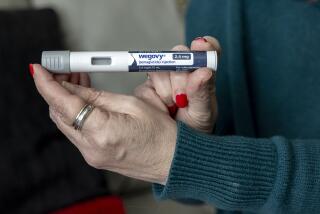Cholesterol Drug Regimen Offers Major Benefits for Heart Patients
- Share via
Offering a “sea change” in the treatment of heart disease, a major study released Monday shows that using maximum doses of statin drugs to sharply lower cholesterol levels of heart attack victims could eliminate more than a quarter of deaths from subsequent attacks.
Some heart attack victims are already given statins, but all should receive them, and they should receive much higher doses than are now used, said Dr. Christopher P. Cannon of Brigham and Women’s Hospital in Boston. The goal is to reduce cholesterol levels well below current standards.
“Our results should be a wake-up call to everyone with heart disease -- that treatment of cholesterol is very important,” Cannon said.
The findings, which come on the heels of several other studies showing major benefits from the drugs, represent a “sea change in cardiovascular prevention,” said Dr. Eric J. Topol of the Cleveland Clinic. “This will mean a major change in the daily practice of medicine.”
About 1.7 million Americans are hospitalized after a heart attack every year, and all of them would benefit from the drugs, Cannon said.
According to current guidelines for lowering cholesterol, about 36 million people should be receiving statins. Only about 11 million are actually taking them.
According to the American Heart Assn., 42% of heart attack victims die within the first year. Overall, nearly 1 million Americans die of cardiovascular disease every year.
Results similar to Cannon’s were reported in November in a smaller study conducted on 654 adults who had heart disease but had not had a heart attack. The new report, to be published in the April 8 issue of the New England Journal of Medicine, extends those findings to a larger number of patients and to those who had already had a heart attack.
Cannon presented the results Monday at a meeting in New Orleans of the American College of Cardiology.
The two reports together provide a powerful justification for widespread use of the drugs to lower cholesterol levels as far as possible.
“There is no such thing as too low a cholesterol level,” said Dr. Steven Nissen of the Cleveland Clinic Foundation, who led the earlier study.
Based on the new findings, all 64 million Americans with heart disease should probably be taking the drugs, which are generally considered to have few side effects.
The statins -- a family of drugs that includes Lipitor, Zocor, Pravachol, Crestor and Lescol -- block cholesterol synthesis by the body and are already among the best-selling drugs in the world.
Their popularity stems from an ability to reduce the rate of heart attacks and strokes in people with a variety of risk factors, even if the patients do not have high cholesterol levels.
They also have a variety of other beneficial effects, including reducing inflammation, protecting against dilation of the heart’s ventricles and decreasing overactivity of the sympathetic nervous system, all of which increase the likelihood of a heart attack.
Cannon and his colleagues studied 4,162 heart attack victims at 349 hospitals in eight countries. The patients were randomly assigned to receive either the standard 40-milligram dose of Pravachol or the highest recommended dose, 80 milligrams, of Lipitor. The same drugs and dosages were used in Nissen’s study as well.
Cannon’s study was funded by Bristol-Myers Squibb, which manufactures Pravachol. Nissen’s was funded by Pfizer, which makes Lipitor.
The team looked at both total cholesterol levels and levels of low-density lipoprotein, or LDL, the so-called bad cholesterol. Current guidelines recommend that LDL levels be reduced below 100 milligrams per deciliter, but experts concede that the guidelines simply represent a “best guess” based on limited scientific evidence.
The guidelines will most likely be lowered based on the new findings.
The team found that the 40-milligram dose of Pravachol reduced the patients’ LDL levels about 25%, to an average of 95. The higher dose of Lipitor reduced it by half, to an average of 62.
Over an average of 2 1/2 years, the patients receiving Lipitor were 16% less likely to suffer chest pain, to require angioplasty or a bypass, to have another heart attack or stroke, and to die.
Overall, their chances of dying were reduced by 28%. Women benefited from the drugs more than men.
The benefits were observed within the first 30 days of the study and were sustained over the entire study period, Cannon said.
“This is a big step downward in the cholesterol [levels], and it made a big step down in the incidence of cardiac events,” Cannon said at the meeting. He emphasized that similar results would probably be obtained if any of the statins, including Pravachol, were used at the same high levels.
Because of the higher doses used in the study, some experts were concerned about an increased risk of side effects, but the observed effects were minimal.
The most significant adverse reaction was an increase in the level of certain liver enzymes, which can be an indicator of potential liver damage.
Such an increase was seen in 3.3% of the Lipitor group, compared with only 1.1% of the Pravachol group. Overall, the physicians discontinued use of the statin in about 2.7% of the Pravachol group because of either increases in liver enzymes or muscle pain. They discontinued the drug in 3.3% of those receiving Lipitor for the same reasons.
The current regimen of the drugs can cost as much as $1,400 a year.






